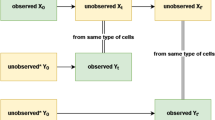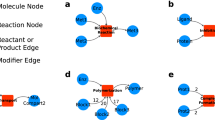Abstract
To test the promise of whole-cell modeling to facilitate scientific inquiry, we compared growth rates simulated in a whole-cell model with experimental measurements for all viable single-gene disruption Mycoplasma genitalium strains. Discrepancies between simulations and experiments led to predictions about kinetic parameters of specific enzymes that we subsequently validated. These findings represent, to our knowledge, the first application of whole-cell modeling to accelerate biological discovery.
This is a preview of subscription content, access via your institution
Access options
Subscribe to this journal
Receive 12 print issues and online access
$259.00 per year
only $21.58 per issue
Buy this article
- Purchase on Springer Link
- Instant access to full article PDF
Prices may be subject to local taxes which are calculated during checkout



Similar content being viewed by others
References
Morowitz, H.J. Isr. J. Med. Sci. 20, 750–753 (1984).
Suthers, P.F. et al. PLOS Comput. Biol. 5, e1000285 (2009).
Browning, S.T. & Shuler, M.L. Biotechnol. Bioeng. 76, 187–192 (2001).
Tomita, M. et al. Bioinformatics 15, 72–84 (1999).
Karr, J.R. et al. Cell 150, 389–401 (2012).
Glass, J.I. et al. Proc. Natl. Acad. Sci. USA 103, 425–430 (2006).
Orth, J.D., Thiele, I. & Palsson, B.O. Nat. Biotechnol. 28, 245–248 (2010).
Covert, M.W., Knight, E.M., Reed, J.L., Herrgard, M.L. & Palsson, B.O. Nature 429, 92–96 (2004).
Edwards, J.S. & Palsson, B.O. BMC Bioinformatics 1, 1 (2000).
Savinell, J.M. & Palsson, B.O. J. Theor. Biol. 155, 215–242 (1992).
Maier, T. et al. Mol. Syst. Biol. 7, 511 (2011).
Gibson, D.G. et al. Nat. Methods 6, 343–345 (2009).
Schelling, P., Folkers, G. & Scapozza, L. Anal. Biochem. 295, 82–87 (2001).
Lester, L.M., Rusch, L.A., Robinson, G.J. & Speckhard, D.C. Biochemistry 37, 5349–5355 (1998).
Leer, J.C., Hammer-Jespersen, K. & Schwartz, M. Eur. J. Biochem. 75, 217–224 (1977).
Fong, S.S. & Palsson, B.O. Nat. Genet. 36, 1056–1058 (2004).
Acknowledgements
We acknowledge support from: an US National Institutes of Health Pioneer Award (5DP1LM01150-05) and an Allen Distinguished Investigator Award to M.W.C.; Siebel Scholars, US National Science Foundation and Stanford University Bio-X Fellowships to J.C.S.; an European Molecular Biology Organization Fellowship (ALTF1371-2011) to S.R.; US National Defense Science and Engineering Graduate Fellowship, US National Science Foundation fellowship, and Stanford Graduate Fellowship to J.R.K.; and Weiland and Rensselaer Engineering Fellowships to M.V.G.
Author information
Authors and Affiliations
Contributions
J.C.S., J.R.K. and M.W.C. performed the simulations and computational analysis; J.C.S., S.R. and S.C. performed the enzyme expression and kinetic assays; J.C.S., J.R.K., M.V.G. and B.B. performed the growth rate measurements; J.C.S., S.R. and M.W.C. wrote the paper; and M.W.C. supervised the project.
Corresponding author
Ethics declarations
Competing interests
J.C.S., J.R.K. and M.W.C. are listed as inventors on a Patent Cooperation Treaty (PCT) international patent application (PCT/US2013/051167) related to whole-cell modeling.
Supplementary information
Supplementary Text and Figures
Supplementary Figures 1–5, Supplementary Tables 2 and 3, and Supplementary Results (PDF 1751 kb)
Supplementary Table 1
Details of the chromosome map and growth assay data. Table listing all of the genes in the M. genitalium genome, together with the model/experimental comparison category, as well as the model predicted and experimentally measured (where applicable) growth rates for each disruption strain in the study and wild type. The sample size, standard deviation, t-test, and Wilcoxon test results are also listed. Six of the genes (MG051, MG112, MG271, MG291, MG385 and MG437) were reported as isolated, but unculturable in our growth assay; we considered these genes essential for the purposes of our study. #N/A = not applicable, this was used in cases where the genes were essential and no quantitative growth rate data could be obtained. (XLSX 67 kb)
Rights and permissions
About this article
Cite this article
Sanghvi, J., Regot, S., Carrasco, S. et al. Accelerated discovery via a whole-cell model. Nat Methods 10, 1192–1195 (2013). https://doi.org/10.1038/nmeth.2724
Received:
Accepted:
Published:
Issue Date:
DOI: https://doi.org/10.1038/nmeth.2724
This article is cited by
-
An expanded whole-cell model of E. coli links cellular physiology with mechanisms of growth rate control
npj Systems Biology and Applications (2022)
-
Integrating protein copy numbers with interaction networks to quantify stoichiometry in clathrin-mediated endocytosis
Scientific Reports (2022)
-
Designing minimal genomes using whole-cell models
Nature Communications (2020)
-
Whole-Cell Modeling and Simulation: A Brief Survey
New Generation Computing (2020)
-
A systems biology approach to discovering pathway signaling dysregulation in metastasis
Cancer and Metastasis Reviews (2020)



